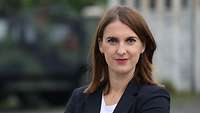




Thomas Hennig is a senior civil servant at the Bundeswehr Technical Centre for Aircraft and Aeronautical Equipment (WTDWehrtechnische Dienststelle 61) in Manching. His position is that of a flight test engineer.
The former temporary-career volunteer studied Aeronautical and Space Engineering at the Bundeswehr University in Munich. He is a qualified aircraft maintenance officer and systems engineer for the Eurofighter weapon system. After his military service, Thomas Hennig completed his career training for the civil service higher-level technical administrative career and switched to the civil service of the Bundeswehr. In addition to his university degree, he completed a training course for flight test engineers in the USA.
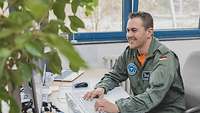
When Thomas Hennig does not work on or in an aircraft, a desk serves as his second workplace. Here, the test results are collected and processed.
Bundeswehr/SchneiderAs a flight test engineer in the field of fighter planes, I am responsible for the planning, execution and review of flight tests of the Eurofighter weapon system. During flight tests, I mainly work at the telemetry station. From there, the test is supervised and controlled. Once a year, I carry out trials outside Manching in what we call a ‘campaign’. These are mostly weapon integration tests on dedicated firing ranges in Sweden, Scotland, Italy, South Africa and the USA. We need to pull out all the stops to successfully and, most of all, safely complete this test project with its constraints in terms of time, personnel and materiel, even with the planning starting well ahead of time.
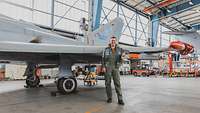
The WTDWehrtechnische Dienststelle 61 in Manching has its own Eurofighter test aircraft. This aircraft is of the IPA 3 type. Beside the standard aircraft systems, this Eurofighter is equipped with test instrumentation and telemetry.
Bundeswehr/SchneiderYes, there is quite a bit of responsibility involved. The essential aspects of technical-logistic operation have to be made clear to the test crews. On the other hand, I need to explain the operational needs of the flight test crews to the technical staff. But you just grow into handling this tension if you keep focused on the success of the project and try to reconcile both sides on a daily basis. Beside the technical qualification, personal leadership skills and team-mindedness are therefore essential for day-to-day work.
First, the main priorities are preparation and planning of the trial. All aspects of the trial, for instance technology, logistics, permits and the flight test crew, need to be identified, planned and reviewed. But the preparation and planning phase is not complete with the final signature under the flight test program. A test safety audit must also be concluded successfully, and the program must be authorized by the director of WTDWehrtechnische Dienststelle 61.
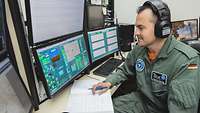
Thomas Hennig is monitoring the test flight from the telemetry station. On the screens, different aircraft measurement values are displayed. These technical data help the engineer to control the flight test.
Bundeswehr/SchneiderIn the test phase, I manage the test briefing before the actual flight test. I monitor and control the test flight itself from the telemetry station. Regrettably, unlike my colleagues from the ‘transporter’ and ‘helicopter’ areas, I never have the opportunity of being aboard for a test flight. A fighter plane has only very limited space, which will be taken up by the actual crew. After the flight test, I manage the post-trial review and collect all test data from the flight test instrumentation for evaluation. In addition, together with the test crew, I draw up a final report.
Yes, of course. In the summer of 2018, I moved there with my family. In Mojave, I then did the one-year training course at the National Test Pilot School to achieve the EASAEuropäische Agentur für Flugsicherheit Category 1 certification as a flight test engineer. EASAEuropäische Agentur für Flugsicherheit – the European Aviation Safety Agency – is responsible for safety and environmental protection in European civilian aviation.
During my training, I learned how to plan and safely conduct trials, how to evaluate results and draw up a final report. The training did not only consist of theoretical lessons in flight performance testing, flight characteristics testing and modern flight control systems. A very comprehensive introduction into testing of aircraft systems was also part of it. In practical training, teams independently plan flight tests. These tests are then carried out by yourself and a trainee test pilot. You subsequently evaluate the results and, finally, produce both a written and an oral report. My personal favorite during the training was the introduction into flight test techniques. Under the supervision of a test pilot, I had the opportunity of doing various, and sometimes extremely dynamic, flight test maneuvers myself.
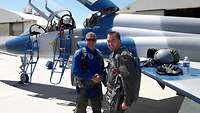
After the first supersonic flight: handshake with the instructor at the National Test Pilot School in the USA.
Bundeswehr/PrivatI don’t believe that there is a better type of engineering profession, which is even closer to piloting operations, than that of a flight test engineer. The first time that I fully perceived the operational world of a pilot was in my internships during career training. I was amazed by the sheer volume and complexity of this world which was entirely new to me. With my piloting experience, I am now much better able to assess the pilot's workload, distribution of focus and thought patterns in relation to the corresponding flight phase.
My job requires the utmost in terms of team working and communication abilities, and leaves no room for routine. Each and every test project bears its own, individual challenges. And: In this job, you should be neither shy nor a loner.
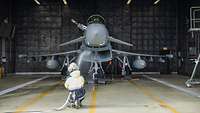
The cleaning of an engine contaminated with de-icing agents is also part of a flight test carried out by a flight test engineer. The test results prove that a new process can lead to a significant increase in engine performance.
Bundeswehr/Schneider